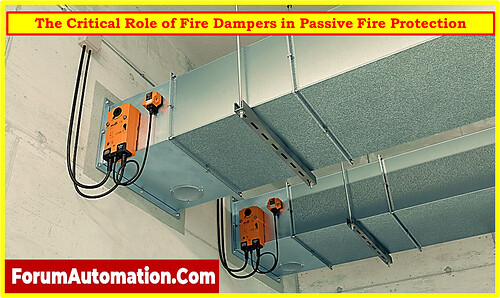How do fire and smoke dampers work?
- A broad variety of components work together to reduce the potentially catastrophic impact of fires in the complex universe of fire protection systems.
- Each characteristic, from the constant ‘exit’ sign to the sophisticated design of cutting-edge sprinkler systems, plays a critical role in containing and mitigating fires.
- Among these, fire dampers, also known as fire shutters, stand out as essential safeguards designed expressly for use in heating, ventilation, and air conditioning (HVAC) ducts. Their major goal is to prevent and isolate fire propagation within the ducting, particularly through fire-resistant walls and floors.
Fire Containment Challenges:
The primary purpose of fire suppression is to protect occupants, limit property damage, and facilitate firefighting activities. While fire walls and doors provide strong barriers, problems occur when construction requirements necessitate HVAC system breaches.
Dampers become critical components in such situations, carefully positioned in ductwork and ceiling cavities to maintain the integrity of fire barriers.
Types of Dampers
Fire Dampers:
When installed near walls or floors, fire dampers serve as alert guardians of fire barriers. These heat-activated dampers close quickly when temperatures reach a predefined set point, acting as a powerful barrier against the spread of fires into neighboring regions.
What is the purpose of smoke dampers?
Smoke Dampers:
Sensitive to smoke, these dampers close on their own to prevent smoke, hazardous gasses, and air from passing past fire barriers. Their critical role tackles one of the leading causes of fire fatalities: inhalation of hazardous gasses and smoke.
Fire/Smoke Dampers:
These are used when a duct requires protection against both fire and smoke. They are a harmonious fusion of features from fire and smoke dampers. They close more gently thanks to electronic release mechanisms, reducing possible pressure difficulties in HVAC systems while providing complete fire and smoke containment.
Why is proper installation of fire dampers important?
Importance of Installation and Maintenance
The efficiency of fire dampers is dependent on careful installation and ongoing maintenance. During a fire, a faulty or partially functional damper can be a vital aspect in the life-and-death equation. Dampers require constant inspection, routine testing, and proactive maintenance to function properly. Building occupants should be educated and trained on the need of maintaining the integrity of these passive fire protection systems on a regular basis.
Fire dampers are critical components of passive fire defense techniques. Their planned location inside HVAC systems not only simplifies building structural requirements, but also provides fire and smoke containment, protecting lives and property. These critical components contribute considerably to the larger goal of improving fire safety within buildings through continual education, thorough installation, and periodic maintenance.
